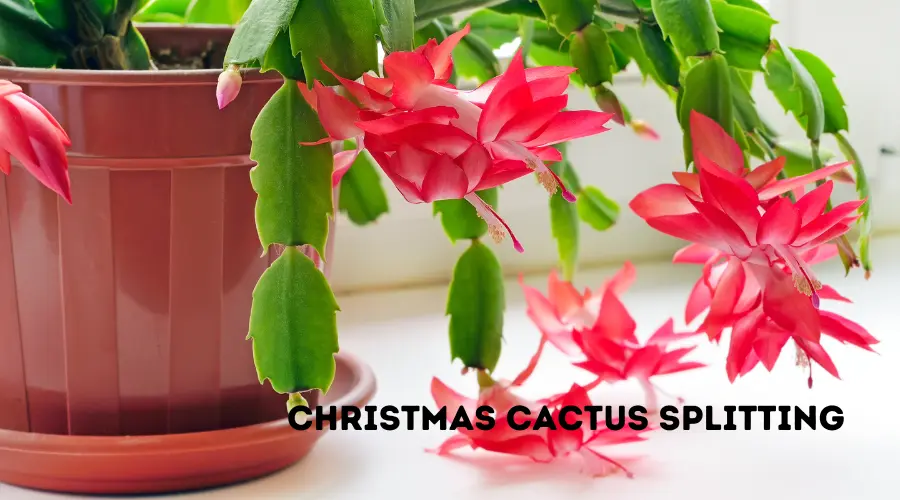Have you ever noticed your Christmas cactus splitting? It’s important to understand why this happens and how to fix it.
In this guide, we’ll explore the reasons behind Christmas cactus splitting and provide simple solutions to keep your plant healthy.

Let’s get started!
What causes the Christmas Cactus to split?
There are several reasons why a Christmas cactus may start to split or crack. Understanding these causes can help you prevent and address the problem more effectively.
1. Overgrown or rootbound plant
- Lack of space for growth: As the plant matures, the roots may outgrow the pot, causing the stem segments to split or crack due to confinement.
- Depleted nutrients in the soil: When the plant becomes rootbound, it can quickly deplete the nutrients in the potting mix, leading to stress and potential splitting.
2. Improper potting mix
- Overly dense or heavy soil: Christmas cacti prefer a well-draining potting mix. Dense or heavy soil can retain too much moisture, causing the stems to swell and eventually split.
- Lack of proper drainage: Poor drainage can lead to waterlogged soil, which can cause the stems to rot and split.
3. Environmental stress
- Extreme temperature fluctuations: Christmas cacti prefer consistent temperatures between 65°F and 80°F. Sudden temperature changes can cause stress and lead to splitting.
- Underwatering or overwatering: Both extremes can stress the plant and contribute to splitting. Overwatering can lead to root rot, while underwatering can cause the stems to shrivel and crack.
- Low humidity levels: Christmas cacti thrive in humid environments. Low humidity can cause the stems to become dry and brittle, increasing the risk of splitting.
Identifying the Splitting Issue
Before addressing the problem, it’s essential to identify whether your Christmas cactus is indeed splitting and determine the extent of the issue.
Checking the Symptoms Visually
- Cracks or splits in the stem segments: Look for visible cracks or splits running along the length of the stem segments.
- Segments falling off the plant: In severe cases, entire stem segments may detach from the plant due to splitting.
Checking the root system
- Signs of overcrowding or rot: Gently remove the plant from its pot and inspect the roots. If they appear overcrowded or show signs of rot (dark, mushy, or foul-smelling), it may be contributing to the splitting problem.
How to fix leaves splitting in Christmas Cactus?
Fix #1: Adjust Lighting and Fertilizer
- Gradually move the cactus into brighter light
- Avoid using Miracle-Gro, as it doesn’t provide the right nutrients for cacti
- Find a cactus fertilizer high in phosphorus and potassium
Fix #2: Change Soil Mix
- Use a mix of 1 part grit (pumice or perlite) and 1 part succulent/cactus soil
- Repot the cactus using this new soil mix
- Wait a week after repotting before watering
Fix #3. Prune the Christmas Cactus
- Prune your Christmas Cactus about a month after it blooms
- Remove 1-2 segments from the ends of the stems
- Pruning will encourage fuller growth and help prevent splitting
Fix #4. Avoid Overwatering
- Ensure your Christmas Cactus is not overwatered
- Allow the soil to dry out between waterings
- Overwatering can cause leaves to split or fall off
Preventing Future Splitting of Your Christmas Cactus
While repotting can address the immediate issue, it’s crucial to follow proper care guidelines to prevent future splitting.
1. Proper watering practices
- Water the plant thoroughly, allowing the soil to dry out slightly between waterings. Avoid letting the soil become completely dry or waterlogged.
- During the plant’s dormant period (winter months), reduce watering to prevent overwatering.
2. Ideal growing conditions
- Temperature: Maintain temperatures between 65°F and 80°F during the growing season and slightly cooler (around 50°F to 60°F) during the dormant period.
- Humidity: Christmas cacti prefer humid environments, around 50-60% relative humidity. Use a pebble tray or humidifier to increase humidity levels if needed.
- Light exposure: Provide bright, indirect sunlight. Avoid direct, intense sunlight, which can scorch the plant.
3. Fertilization schedule
- Feed the plant with a balanced, water-soluble fertilizer every 2-4 weeks during the growing season (spring and summer).
- Avoid fertilizing during the dormant period (fall and winter).
4. Repotting frequency
Repot the plant every 2-3 years, or when the roots become overcrowded, to provide fresh potting mix and more space for growth.
5. Using stakes or supports for larger plants
As the Christmas cactus grows larger, the weight of the stem segments can cause them to droop or split. Use stakes or a support ring to gently hold the stems upright and prevent splitting.
6. Propagating new plants from split segments
If you have split or detached stem segments, you can propagate them to create new plants.
Allow the cut ends to callus over for a few days, then insert them into a well-draining potting mix. Keep the soil moist, and new roots should develop in a few weeks.
Conclusion
Let’s conclude the post on Christmas Cactus Splitting!
I hope you have now a good idea on this topic by reading this post.
Please feel free to Pin This!


